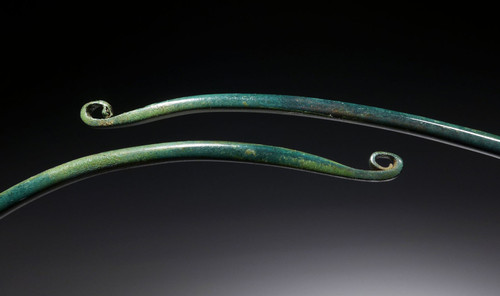Product Description
A classic object of personal adornment and wealth, this is a rare set of THREE unbroken decorative twisted bronze torque necklace collar rings from the Middle Bronze Age of Central Europe. They were originally found in Germany and feature excellent preservation with intact decorative designs. European Bronze Age jewelry pieces like this is not common with torque neck rings and larger pieces being far more rare than simple finger rings since the necklace required more bronze to make and greater work to hand-fabricate versus simple casting.
Large twisted torque neck rings of this design are scarce but when found, most often are broken due to their fragile nature. Here we have THREE UNBROKEN and complete examples of a alternating hand-twisted design. The ability to make these torques required a high level of advanced metalsmithing skills across a multitude of abilities. First, a round wire was drawn through a plate with a square hole to form the square wire. After this, the wire was twisted, and in the case of these rings, done in alternating directions to create the decorative spots seen throughout each ring. Since each was hand-wrought, the work-hardening would have given the rings strength and spring tension, allowing them to have been twisted to put on and take off (not safe to do now due to its age). Aside from the minor losses, all are complete and in very good preservation with a beautiful green bronze patina that European Bronze Age metal objects are so treasured for.
Cleaned and treated in our lab to protect and preserve the integrity of the metal and allow safe handling. Be wary of modern copies that plague the antiquity market today. We subject every artifact we offer for sale to rigorous inspection and authentication in our own museum lab facility.
SEE MORE EUROPEAN BRONZE AGE ARTIFACTS
HISTORY
The Tumulus culture dominated Central Europe during the Middle Bronze Age (c. 1600 to 1200 BC). It was the descendant of the Unetice culture. Its heartland was the area previously occupied by the Unetice culture besides Bavaria and Württemberg. It was succeeded by the Late Bronze Age Urnfield culture. The Tumulus culture was eminently a warrior society, which expanded with new chiefdoms eastward into the Carpathian Basin (up to the river Tisza), and northward into Polish and Central European Únětice territories. The culture's dispersed settlements centred in fortified structures.
As the name implies, the Tumulus culture is distinguished by the practice of burying the dead beneath burial mounds (tumuli or kurgans). The Tumulus culture was prevalent during the Middle Bronze Age. Tumuli have been used elsewhere in Europe from the Stone Age to the Iron Age yet, the term "Tumulus culture" specifically refers to the South German variant of the Bronze Age.
 US DOLLAR
US DOLLAR
 EURO
EURO
 AUSTRALIAN DOLLAR
AUSTRALIAN DOLLAR
 CANADIAN DOLLAR
CANADIAN DOLLAR
 POUND STERLING
POUND STERLING
















